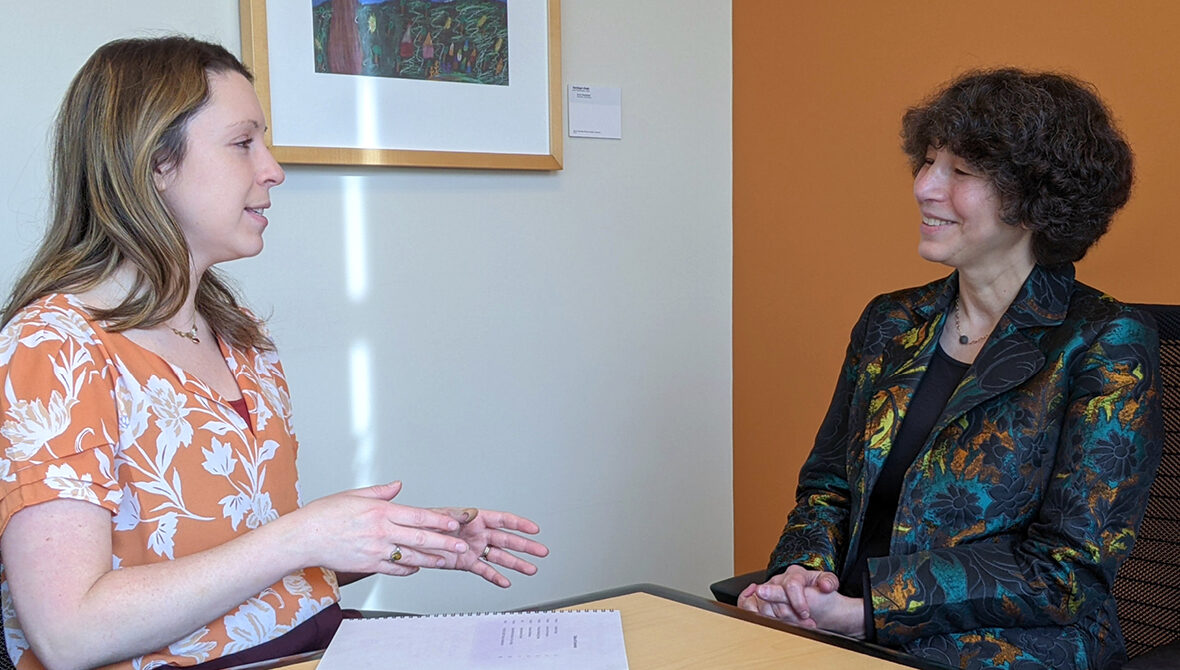Meet Lesley Slavitt, Eighth Executive Director of the Johnson Center


As we celebrate our 30th anniversary and greet new leadership, we are reflecting deeply on our impact to date and looking to the future with optimism and energy. As an organization, as individuals, and as members of myriad communities, we know we are living in complex and weighty times. We respond by leaning into the strength of our team and of our partnerships, together envisioning strong, inclusive communities where smart, adaptive philanthropy thrives.
On her first day in the office, Lesley sat down with Tory Martin, the center’s director of communications and strategic partnerships, to share more about her vision for the Johnson Center’s future — and a bit about herself.
Tory Martin: Lesley, welcome! We are so happy to have you onboard. Let’s begin with the Johnson Center itself. As a university-based applied research center, we bridge the gap between the information communities need and the change they want to make. Can you share with us what initially drew you to this role?
Lesley Slavitt: An affinity of values. I believe deeply in the mission and purpose of the Johnson Center and its relevance to the public good. Having had the privilege of working in the sector for many years, I have seen the effect of information and knowledge gaps on the ability of stakeholders to ensure our best work. The center not only bridges those gaps but also provides critical tools necessary to address them.
Community change is serious work, and it should be treated seriously. That’s where “research to practice” is essential. The people and organizations doing this work need access to robust data, insights, and support they can use to build the best possible present and future for all of us.
You’ve been in philanthropy and higher education for nearly 30 years. How do you see the field of philanthropy changing, and how will the Johnson Center, under your leadership, evolve to meet these emerging needs?
I cannot give better insights than the piece produced last year by the Johnson Center as it reflected on the center’s 30 years: Philanthropy 1992-2022, by Frey Foundation Chair for Family Philanthropy Dr. Michael Moody. It not only provides meaningful context and reflections but helps us understand where the field is going.
That said, the report generally coincides with my own career progression, which was interesting for me personally. If I think back from that beginning to now, there are two areas of note: one, the vastly expanded scale and scope of philanthropy and, two, its professionalization, which has a meaningful connection to higher education.
Philanthropy’s pragmatic entry into higher education has ensured that practice has disciplinary boundaries and hones skills and knowledge that advance the effectiveness of the field, nurture advanced learning, and ensure new knowledge creation. Higher education has been and, I believe, will become even more essential to philanthropy’s future.
What are your early priorities?
My first priority is not to break anything! I need to listen and learn. I am privileged to join an organization with a remarkable legacy, incredibly dedicated and talented staff, and knowledgeable, savvy stakeholders.
How do you see the Johnson Center serving local, national, and international audiences?
Philanthropy is a field of practice, which can be place-based in its application and defy boundaries, simultaneously. There are many affinities that cross local, national, and global practice that offer meaningful insights and lessons. The Johnson Center is uniquely positioned to serve as an interpreter and nexus for the ideas, practices, successes, challenges, and opportunities of philanthropy.
Let’s turn our attention a little closer to home. How do you see the Johnson Center and the executive director position fitting within Grand Valley State University and West Michigan more broadly?
There is a natural alignment between the Johnson Center and public higher education, as I mentioned, but there is an essential values alignment between the center and GVSU. In co-founding the center with the W.K. Kellogg Foundation at the very forefront of the field in 1992, GVSU put those values into action. In doing so, GVSU helped to incubate and advance the field in partnership with a community of stakeholders — largely though not exclusively in West Michigan — who likewise were committed to advancing philanthropy and the public good.
When I look at the timeline of the Johnson Center’s history, I see so many examples of the richness of the relationship between the center and the other departments of GVSU — with the libraries, with faculty, with students. I look forward to building on those experiences, getting to know my new colleagues, and finding continued opportunities to enrich each other through our shared institution.
Now let’s get to know you a bit better. What nonprofits or social causes are closest to your heart?
I lived in Flint, Mich., during the water crisis and, while I no longer live there, I continue to work with a North Flint grassroots community organization.
I have also been fortunate to work with organizations that reflect and have supported the personal journeys of some important people in my life and, as a result, organizations supporting those who survived the killing fields in Cambodia and those with accessibility issues who can have barriers to full participation in society are close to my heart.
What can’t you do without?
Pizza. More specifically, pizza margarita. I’m a vegetarian, and I love to travel. One of the things I learned years ago is that “pizza margarita” is the universal language of a “vegetarian safe” meal, which is relatively the same country-to-country and an order universally understood. It requires no translation! It’s my absolute go-to food. I also — luckily — happen to really like it, so it’s a popular home cooking option too.
Lastly, how should people get in touch with you?
The best way to reach me, especially at first, will be via email. I look forward to connecting with the community!